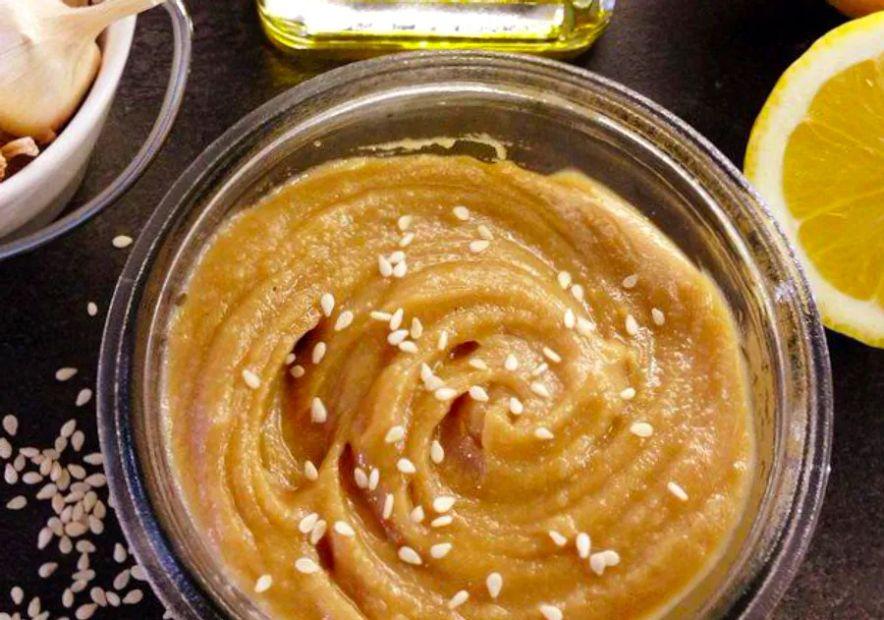What Exactly Is Tahini?

Tahini has been a staple in Mediterranean, Middle Eastern, and North African cooking for centuries. In many Middle Eastern cultures, it's as common on the table as salt and pepper, used to enhance the flavor of nearly every meal.
What Is Tahini and What Is It Made Of?
Tahini is a rich, creamy paste made from ground sesame seeds, which are naturally packed with oil — roughly 50% of their weight. Some variations may include added oil, salt, or other flavorings.
A key ingredient in classic Middle Eastern hummus, tahini also serves as a thickener and flavor enhancer for sauces and dressings. It can even be used in baked goods, making it the Middle Eastern counterpart to peanut butter.
What Are the Various Kinds of Tahini?
Tahini comes in two varieties: hulled and unhulled. Hulled tahini is made from sesame seeds with the outer shells removed, giving it a lighter, creamier consistency. It contains fewer nutrients and less fiber. Unhulled tahini uses the whole sesame seeds, offering a slightly more bitter taste and retaining more of the nutritional benefits.
Additionally, tahini can be raw or roasted. Raw tahini has a milder flavor, lighter color, and a higher nutrient content than roasted tahini.
Tahini comes in a range of colors, from pale sandy tones to rich brown. Lighter versions are made from sesame seeds without the hull, and can be either raw or roasted. Roasted tahini is darker with a bolder flavor compared to its raw counterpart. Darker tahinis, often sold in block form, use sesame seeds with the hulls intact, giving them a coarser texture and a more intense, sometimes slightly bitter, toasted flavor.

The Nutritional Benefits of Tahini
Tahini retains much of the nutritional value of sesame seeds. Rich in healthy fats, it provides essential fatty acids and is a great source of calcium, making it an excellent alternative for those avoiding dairy. While tahini offers a solid amount of protein, minerals, and unsaturated fats, it's also calorie-dense, so it's best enjoyed in moderation. A small tablespoon goes a long way.
Tips for Buying Tahini
Tahini is commonly found in grocery stores either alongside condiments like peanut butter or in the international foods section. You can also purchase it at specialty or Middle Eastern markets. It is shelf-stable and typically sold in glass or plastic jars, and does not require refrigeration.
How to Properly Store Tahini
Before using tahini, give it a good stir, as the oil tends to separate during storage. After opening, you may need to mix the oil back into the paste. To keep it fresh, store the jar in the fridge. Tahini can last for several months, but over time, the oils may become rancid. Always give it a sniff and taste to ensure it's still good before using it in recipes.
How to Prepare Homemade Tahini
Making your own tahini is simple and requires just a few ingredients. You'll need sesame seeds, oil, and a pinch of salt, if desired. Begin by spreading 1 cup of sesame seeds on a baking sheet and toast them in the oven at 350°F for 10-12 minutes, stirring occasionally, until they become fragrant.
After the seeds have cooled, place them in a blender or food processor and add 1/4 cup oil (olive oil or sesame oil work well). Blend until smooth, adding salt to taste, and more oil if needed to achieve the right consistency. Store your homemade tahini in a sealed container in the fridge.
Get the Recipe: Tahini
Ways to Use Tahini
- Mix it into appetizers
Tahini originates in Middle Eastern and Mediterranean cooking, where it's used to flavor appetizers and spreads such as hummus and baba ghanoush, salad dressings, and sauces for falafel. Tahini is most widely used as the main ingredient (behind chickpeas) in traditional hummus, giving a notable and appealing nutty flavor to this Middle Eastern staple. You can also add a spoonful to pureed carrots or beets for a vegetable hummus that is lovely to look at and tastes great — an excellent option for a party appetizer.
- Whisk it into a dressing
Tahini makes an excellent vinaigrette ingredient — its thick texture gives the illusion of a cream-based dressing for salads and dipping vegetables. Try adding some to your favorite dressing recipe, or add some soy sauce or vinegar to tahini as a vinaigrette base.
- Incorporate it into a sauce
You may also use tahini as a savory sauce by thinning with water and adding lemon juice and chopped garlic for flavor. This condiment can be used on anything from roasted vegetables to grilled meats. You can even use it to make barbecue sauce.
- Blend it into breakfast
Tahini make an excellent addition to smoothies and oatmeal -- just stir or blend in a spoonful, which will lend both flavor and nutrition. You can also mix tahini and honey together, with or without cinnamon, for a delicious plant-based spread to enjoy on bagels, English muffins, or toast.
- Try it in your desserts
For a healthy sweet ending to meals, sweetened tahini can also be drizzled over a fresh fruit platter. Blend it with a spoonful of honey or maple syrup and thin with water until the consistency is to your liking. Swirl some into your brownies or try making cookies. Tahini has even found its way into ice cream.

Tahini Substitutes
If you're out of tahini for a recipe, don't worry! Since tahini is made from sesame seeds, most nut butters can step in as substitutes. Opt for unsweetened varieties like peanut butter, cashew butter, or sunflower seed butter, which offer a similar flavor. For an added touch, you can mix in a bit of sesame oil to bring in the tahini-like flavor. However, keep in mind that while sesame oil can enhance the taste, it won’t do much for texture, so it's best paired with a smooth nut butter like cashew.
Evaluation :
5/5



